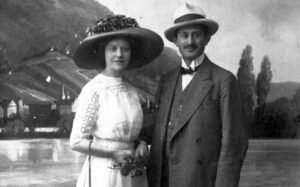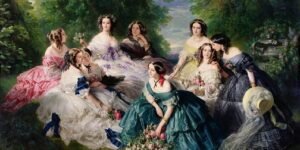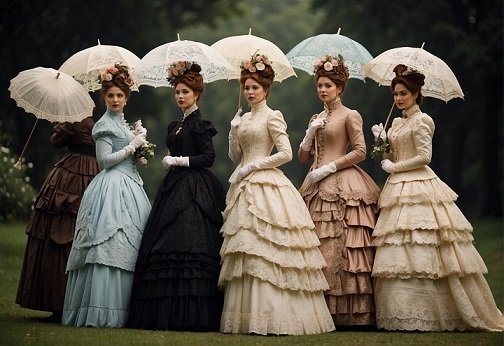Table of Contents
ToggleFemale Upper Class Victorian Era Fashion: A Detailed Exploration of 19th Century Style
The Victorian era, spanning from 1837 to 1901, was a period marked by significant societal changes, technological advancements, and artistic developments. When it comes to fashion, the upper class in Victorian England led the way, with elaborate clothing serving as both a symbol of wealth and a reflection of the strict social hierarchy of the time. Female Upper Class Victorian Era Fashion.
In this post, we will take a deep dive into the intricacies of female upper-class Victorian fashion. We will explore the key elements of the era’s clothing styles, the evolution of women’s attire through the 19th century, and how these fashions mirrored the roles and expectations placed on women in Victorian society.
The Role of Fashion in Victorian Society
Fashion in the Victorian era was not merely about clothing; it was a reflection of one’s social status, personal wealth, and moral character. The upper classes, including the aristocracy, gentry, and wealthy merchants, were the main trendsetters in fashion. Their clothing was designed to demonstrate their affluence, while also adhering to the strict moral codes of the time. A lady’s appearance was a direct reflection of her family’s status and respectability.
The fashion choices of upper-class women were governed by various factors, including etiquette, gender norms, and societal expectations. This led to the development of elaborate and highly structured garments that would often require several hours of dressing and assistance from servants or maids.
Key Elements of Female Upper-Class Victorian Fashion

1. Corsets and Bustles
Corsets were perhaps the most iconic aspect of Victorian women’s fashion. These garments were worn to shape and control the body, creating an exaggerated hourglass figure. Corsets were tightly laced around the waist, often creating a dramatic contrast between a narrow waist and a fuller bust and hips.
Material and Construction of Corsets:
Victorian corsets were typically made from heavy fabrics like silk, satin, or cotton. They were reinforced with whalebone or steel stays to maintain their rigidity. The use of tight lacing could lead to discomfort and health issues, such as difficulty breathing and fainting spells, but it was considered a necessity for any well-dressed woman.
By the late Victorian period, the introduction of the bustle became another key element of women’s fashion. Bustles were worn to create a pronounced, rounded silhouette at the back, giving the appearance of a fuller figure. This trend evolved from the earlier crinoline hoop skirts and helped shape the shape of Victorian dresses from the mid to late 19th century.
2. Dresses and Gowns
Victorian dresses were designed to be elaborate, often featuring multiple layers of fabric, including petticoats, underskirts, and crinolines (hoop skirts) for volume. These dresses were made of luxurious fabrics such as velvet, silk, and satin, adorned with intricate lace, ribbons, and trims.
Silhouettes Over Time:
In the early part of the Victorian era (1837–1850), women wore dresses with full skirts supported by crinolines or petticoats, and the bodices were often quite fitted. By the 1860s, the fashion started to shift towards more streamlined designs, with skirts that were fuller in the back to accommodate the growing popularity of the bustle.
In the 1870s and 1880s, dresses had a distinctive hourglass shape, with tight bodices, long sleeves, and expansive skirts. The skirts often featured layers of lace, ribbons, or embroidered details. Victorian women also accessorized their gowns with matching gloves, hats, and jewelry.
3. Colors and Fabrics
The colors of the upper-class Victorian gowns varied significantly depending on the season, occasion, and personal preference. Lighter, pastel shades like pale pink, lavender, and light blue were popular for spring and summer, while darker hues such as black, burgundy, and deep blue were preferred for fall and winter.
Fabrics:
The choice of fabric was paramount in Victorian fashion. Silk was the most prestigious fabric, but wool, cotton, and satin were also commonly used. Brocades, damasks, and velvets were particularly popular for formal gowns, while everyday dresses were often made from lighter materials such as cotton or linen.
4. Accessories and Hairstyles
Hats and Bonnets:
Hats were a major component of a woman’s outfit during the Victorian era, and different hats were worn for different occasions. Bonnets were particularly popular for daytime wear. These were made from fine fabrics like silk, decorated with feathers, ribbons, or lace.
Jewelry:
Upper-class women often wore lavish jewelry, including lockets, brooches, earrings, and bracelets, crafted from gold, silver, and precious stones. The type of jewelry worn often signified one’s wealth and social standing.
Hairstyles:
Hairstyles in the Victorian era were often elaborate. For formal occasions, women would style their hair in intricate updos, sometimes incorporating curls, braids, or twists. In the earlier years of the Victorian era, women wore their hair in ringlets or loose waves, while later in the period, hair was styled in more refined and controlled shapes, often atop the head in tight coils or rolls.
Social Expectations and Fashion

Fashion in the Victorian era was closely tied to a woman’s social role. As women were often expected to be the epitome of domesticity and modesty, their fashion reflected these qualities.
1. Modesty and Layers
Upper-class women were expected to maintain a sense of modesty at all times. Their clothing was designed to cover the body, with high collars, long sleeves, and full skirts that adhered to these ideals. The structured, layered nature of the garments helped convey a sense of propriety.
2. Class and Wealth Indicators
The design and materials used for upper-class women’s fashion were distinct markers of wealth. Fabrics such as silk and velvet, the extensive use of lace, and the fine detailing of garments all indicated a woman’s high social status. These items were often custom-made by dressmakers or fashion houses, and garments were frequently handed down through generations.
Table: Evolution of Female Upper-Class Victorian Fashion (1837–1901)
| Time Period | Fashion Characteristics | Key Trends |
|---|---|---|
| 1837–1850 | Full skirts, tight bodices, high collars, crinolines (hoop skirts). | Early Victorian dresses, Corsets |
| 1850–1860 | Wide skirts, frills, and lace. Prominence of tightly fitted bodices and full skirts. | Crinolines, Day dresses |
| 1860–1870 | The bustle appears, skirts fuller in the back. Tight bodices, long sleeves. | Bustles, Structured Silhouettes |
| 1870–1880 | Bustles dominate, fuller back silhouette, high necklines, long sleeves, and intricate lace. | Victorian Bustle Era |
| 1880–1900 | Elongated skirts, extravagant decoration with lace, ribbons, and luxurious fabrics. | Formal evening wear, Elaborate Gowns |
Impact of Victorian Fashion on Today’s Style
Though Victorian fashion might seem distant, its influence continues to echo through modern fashion. Elements like the corset, bustles, and intricate decoration can be seen in contemporary haute couture, and the period’s use of color and luxurious materials still inspires designers today.
Conclusion: The Legacy of Female Upper-Class Victorian Fashion
Victorian fashion was more than just clothing; it was an intricate part of the social structure of the time, revealing much about class, wealth, and gender expectations. The upper-class Victorian woman’s wardrobe was a symbol of her place in society, and every piece of clothing, from the corset to the bonnet, was designed to reinforce these roles.
Despite the discomforts and constraints imposed by such elaborate fashion, these garments remain a testament to the artistry and craftsmanship of the time. Today, we continue to be fascinated by the elaborate designs and the rich social history that they represent.
Disclaimer: This article provides general information and insights into the fashion of the Victorian era. While efforts have been made to ensure accuracy, interpretations of fashion trends and societal norms may vary. This article should not be taken as an exhaustive source of historical fashion, but rather as an introductory exploration of the subject.
